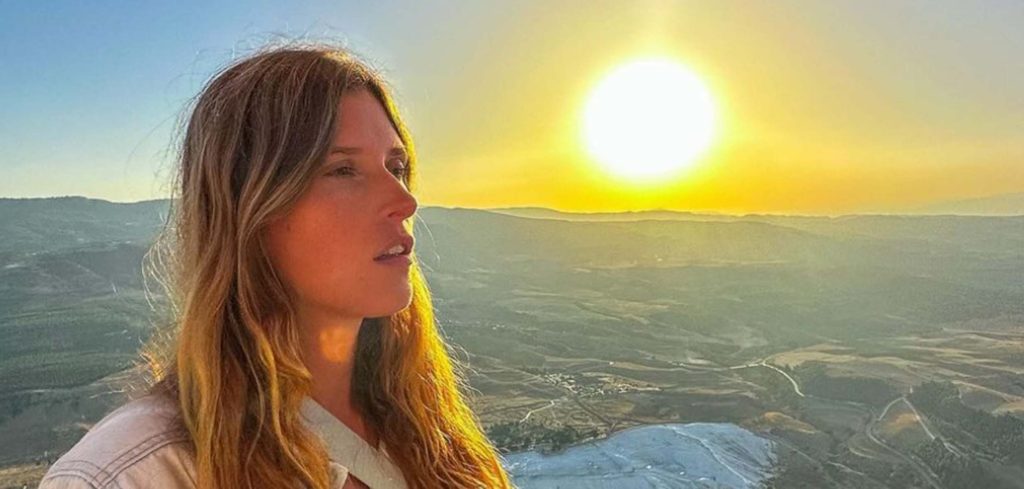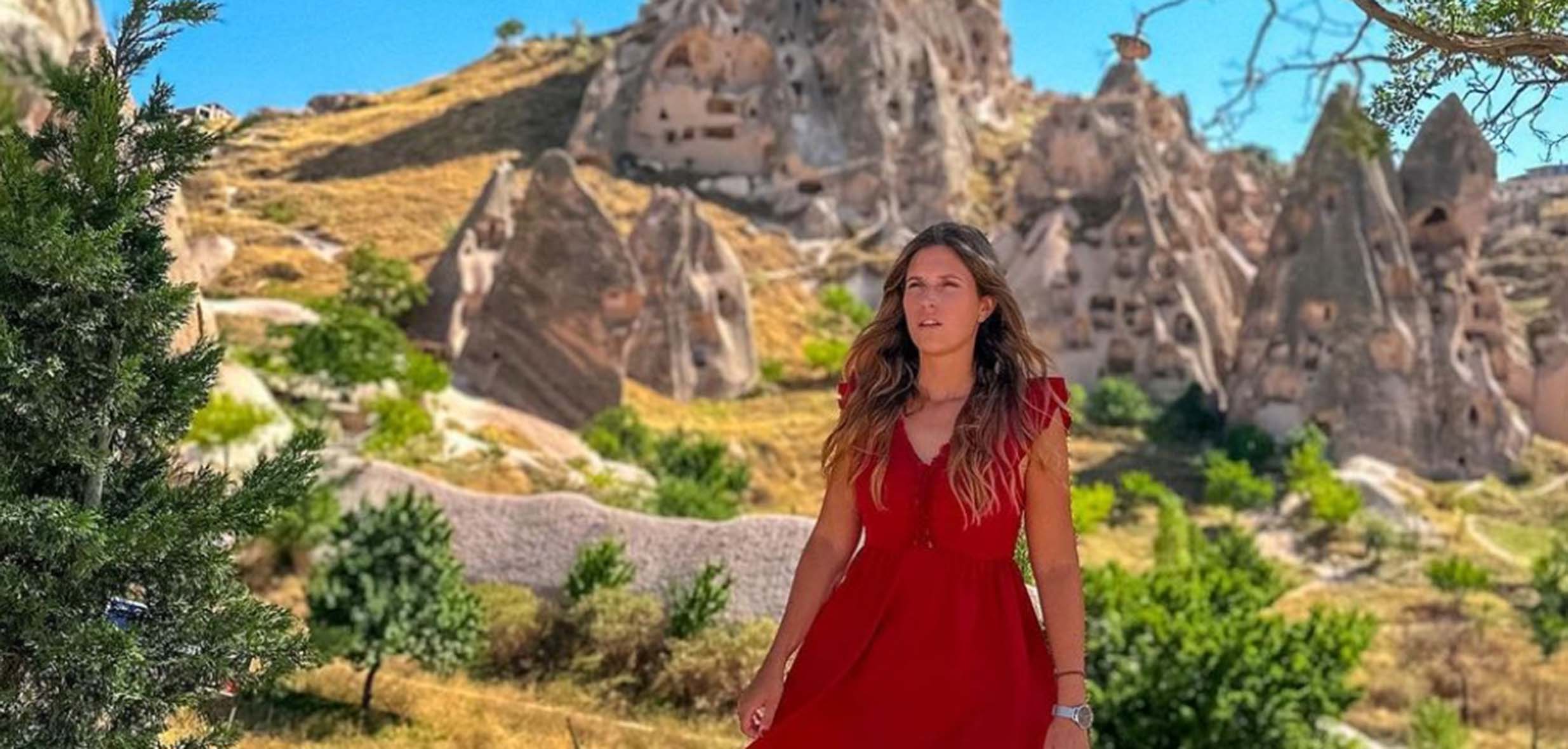Pamukkale, located in southwestern Turkey, is a mesmerizing natural wonder renowned for its unique geological formations and historical significance. The name “Pamukkale” translates to “Cotton Castle” in Turkish, a fitting description for the dazzling white terraces formed by calcium-rich mineral deposits over thousands of years.
These terraces, resembling cascading pools of water, are the result of hot springs creating travertine, a type of limestone that solidifies into these mesmerizing formations. The stark white terraces against the azure sky create a surreal and ethereal landscape, often likened to a snowy wonderland in the midst of the Turkish countryside.
Beyond its natural beauty, Pamukkale holds historical importance as the site of the ancient city of Hierapolis. This UNESCO World Heritage Site was once a thriving Greco-Roman city, known for its thermal springs believed to have healing properties. The remnants of Hierapolis include well-preserved theaters, temples, and ancient streets, providing a captivating glimpse into the past.
Visitors flock to Pamukkale not only to witness its surreal landscape but also to experience the therapeutic benefits of its thermal waters. The hot springs have drawn people seeking rejuvenation and healing for centuries, making Pamukkale not just a visual spectacle but also a destination for wellness and relaxation.
Overall, Pamukkale’s significance lies in its dual offering—a natural wonder with its striking terraces and a historical site that unveils the ancient splendor of Hierapolis. This blend of natural beauty and historical heritage makes Pamukkale a must-visit destination for travelers seeking both enchanting landscapes and cultural immersion.
1. Walking through the Limestone Terraces:
The natural terraces of Pamukkale are a breathtaking sight, almost otherworldly in their appearance. These cascading pools of mineral-rich water create a landscape that seems pulled out of a fairy tale. The brilliant white coloration of the terraces against the backdrop of clear blue skies is nothing short of enchanting. As the mineral-rich water flows down the slopes, it deposits calcium carbonate, forming these stunning travertine formations that seemingly glow in the sunlight.
To truly immerse oneself in this surreal beauty, exploring the terraces on foot is a must. The best walking routes weave through the terraces, allowing visitors to marvel at the intricate details and crystal-clear pools. The main route starts at the entrance and gradually ascends, unveiling various levels of terraces. While strolling through these pools is allowed in some areas, visitors are encouraged to remove their footwear to protect the delicate formations.
For the most awe-inspiring viewpoints, climbing to the higher terraces is recommended. Here, one can gaze down upon the lower pools, capturing panoramic views that showcase the sprawling beauty of Pamukkale. The landscape changes with the angle of the sun, offering different hues and reflections throughout the day, making each moment a unique spectacle.
When planning a visit, it’s advisable to check the ticketing and entry information in advance. Ticket reservations can often be made online or purchased at the entrance. Prices vary depending on whether visitors are locals or international travelers, and there might be additional fees for access to specific areas or facilities. As for operating hours, Pamukkale is typically open from early morning to sunset, allowing visitors ample time to explore and bask in the beauty of this natural wonder.
Visiting during the early morning or late afternoon is recommended not only for favorable lighting but also to avoid the peak crowds that flock to this iconic site. Additionally, wearing comfortable footwear and carrying water is advisable for the walk, ensuring a pleasant and enjoyable exploration of Pamukkale’s mesmerizing terraces.

2. Bathing in the White Travertines:
Bathing in the natural pools of the white travertines at Pamukkale is an extraordinary experience, akin to immersing oneself in a natural spa. As visitors wade through these pools, the mineral-rich waters create a rejuvenating sensation, believed to offer therapeutic benefits to the skin and body. The temperature of the pools varies, some being pleasantly warm while others might be cooler, providing a range of experiences for bathers.
The lime deposits in the water, formed from calcium carbonate, are renowned for their nourishing effects on the skin. The water’s mineral composition is said to promote skin health, leaving it feeling silky smooth after the bath. Many visitors revel in this unique opportunity to indulge in nature’s own skincare treatment, feeling revitalized after a leisurely soak in the travertine pools.
To access the travertines, tickets can usually be purchased on-site or through online reservations. Prices may differ for locals and international tourists, and additional fees might apply for specific areas or facilities. It’s advisable to check the official website or local tourism offices for updated ticketing information, as prices and entry requirements can vary.
Operating hours for the travertines usually align with the general visiting hours of Pamukkale, opening early in the morning and closing around sunset. To make the most of this experience, arriving early or later in the day can offer a more serene atmosphere, allowing for a tranquil bathing experience amidst the stunning natural surroundings.
3. Exploring Ancient Hierapolis:
Hierapolis, the ancient city adjacent to Pamukkale, holds profound historical significance dating back to Hellenistic and Roman times. This UNESCO World Heritage Site was once a thriving city, known for its thermal springs and healing centers. Exploring Hierapolis offers a captivating journey through time, with well-preserved ruins that offer glimpses into daily life in antiquity.
The standout feature of Hierapolis is its impressive theater, a grand structure that once hosted theatrical performances and events. This amphitheater, with its commanding presence and remarkable acoustics, serves as a testament to the city’s cultural richness.
Beyond the theater, Hierapolis boasts a plethora of ruins including temples, baths, necropolises, and intricate mosaic-adorned streets. These remnants offer a mosaic of history, painting a vivid picture of the city’s prosperity and cultural vibrancy during its prime.
For visitors interested in exploring Hierapolis, tickets can usually be purchased separately or as part of combined tickets that include access to Pamukkale’s travertines. Costs for entry may vary, and it’s advisable to inquire about any guided tours or additional services available at the site. Operating hours typically align with those of Pamukkale, allowing ample time for exploration and discovery within this ancient marvel.

4. Swimming in Cleopatra Antique Pools:
The Cleopatra Antique Pools in Pamukkale offer a truly unique swimming experience steeped in history. Legend has it that these mineral-rich pools were enjoyed by Cleopatra herself, adding an air of mystique to the place. The crystal-clear waters, adorned with ancient columns and submerged ruins, create a serene ambiance for swimmers.
Access to the Cleopatra Pools typically requires a separate ticket, which can be purchased on-site or through advance reservations. Prices might vary based on visitor categories, and it’s advisable to check the official website or local authorities for updated ticketing information. The pools usually operate during the same hours as Pamukkale, allowing visitors to enjoy a refreshing swim amidst antiquity.
5. Discovering the Ruins of Laodikeia:
Laodikeia, an ancient city near Pamukkale, holds significant historical and archaeological importance. As a prominent city in the ancient world, Laodikeia was renowned for its textile industry and served as a center for trade and commerce.
Visitors exploring Laodikeia can witness well-preserved ruins that offer insights into the city’s past glory. The remains of theaters, temples, baths, and streets adorned with intricate mosaics provide a glimpse into the architectural and cultural richness of the ancient city.
To visit Laodikeia, tickets might be available at the entrance, with varying prices for different visitor categories. Opening times and entry fees can fluctuate, so it’s recommended to check with local tourism authorities or official sources for accurate information before planning a visit.
6. Overlooking Pamukkale in a Hot Air Balloon:
Riding in a hot air balloon over Pamukkale unveils a breathtaking panoramic view of this stunning landscape. The surreal beauty of the travertine terraces, as seen from above, offers a perspective unlike any other.
Arranging a hot air balloon ride can typically be done through local tour operators or agencies specializing in aerial tours. Prices may vary based on the duration and services included in the ride. It’s advisable to book in advance, especially during peak tourist seasons, to secure a spot for this unforgettable experience.

7. Relaxing in Karahayit Hot Springs:
Karahayit Hot Springs, near Pamukkale, offer a serene escape amidst picturesque landscapes. The springs are known for their mineral-rich waters believed to have therapeutic properties beneficial for health and relaxation.
Access to the hot springs might involve purchasing tickets, with prices differing based on various factors such as services offered and visitor categories. Operating hours can vary, so it’s advisable to check in advance. Visitors can enjoy a rejuvenating experience in a tranquil setting, surrounded by nature’s beauty.
8. Visiting the Hierapolis Archaeological Museum:
The Hierapolis Archaeological Museum showcases an impressive collection of artifacts and historical treasures unearthed from the ancient city and its surroundings. Visitors can explore exhibits featuring sculptures, inscriptions, pottery, and other relics that offer insights into the region’s rich history.
Tickets for the museum are usually available at the entrance, with entry fees varying for different visitor categories. The museum operates within specified hours, aligning with the general visiting hours of Pamukkale and Hierapolis. It’s recommended for history enthusiasts and curious travelers eager to delve deeper into the region’s past.
9. Paragliding Over the Travertines:
Paragliding over Pamukkale’s travertines offers an exhilarating adventure and a bird’s-eye view of the stunning landscape. The thrill of soaring above the terraces and witnessing the breathtaking panorama from high above creates an unforgettable experience for adrenaline seekers.
Booking a paragliding flight can usually be arranged through certified operators or tour agencies offering this adventurous activity. Prices may vary based on flight duration and additional services. It’s advisable to ensure the operator’s credibility and safety standards before booking this thrilling experience.
10. Day Trip to Salda Lake:
Salda Lake, often dubbed the “Turkish Maldives,” captivates visitors with its crystal-clear waters and pristine white sandy beaches. The lake’s beauty is further enhanced by its resemblance to the landscapes of a tropical paradise.
Taking a day trip to Salda Lake involves arranging transportation, which can be done through various means such as organized tours, rental cars, or public transport. Entry to the lake might require nominal fees, and it’s advisable to check for any regulations or restrictions before visiting. The best times to visit Salda Lake are during clear weather, allowing for the full appreciation of its beauty and tranquility.
Each of these experiences offers a unique perspective on the wonders surrounding Pamukkale, catering to a wide array of interests and preferences for travelers seeking exploration, relaxation, and adventure.



